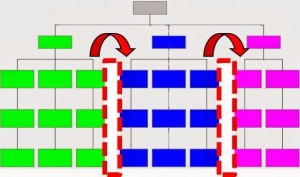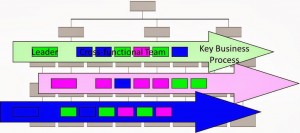Where do organizational “white space” problems come from? Our DNA. But we can also use our genetic predisposition to solve them.
Chances are you’ve experienced it. When you call a company for help, you get the proverbial runaround. After explaining the problem and hearing “That’s not my department” several times, you’re transferred endlessly, leaving voice mails that go unanswered. It’s totally frustrating. Nobody takes responsibility because your issue falls between the cracks–into the “white space.”
You may work in an organization that behaves this way. Within your group, people perform tasks smoothly, but there’s friction with other groups. All too often, work doesn’t flow. Stuff gets “thrown over the wall,” there’s finger-pointing when things go wrong, and customers pay the price. The “white space” between the boxes on the organization chart is usually where the ball gets dropped.1
White space issues can paralyze. Legendary for silos, General Motors’ white space issues led to long, costly product development cycles and poor quality. Rather than cooperating, some departments wouldn’t even speak to each other. Flawed management philosophies such as Management by Objectives and pay-for-performance made the situation worse, causing sub-optimization—an insidious game of “I win, we lose” between functions. In a failed attempt to change, GM implemented a complex, matrix-management scheme that confused who was in charge, diluted accountability, and put the company in decline.2 And GM isn’t alone. So widespread are white space effects in industry that quality master W. Edwards Deming highlighted them in point nine of his famous Fourteen Points for Management: “Break down barriers between departments.”3
Experts cite the lack of a “systems view” as the cause for white space problems. Most managers perceive the organization’s work as vertical and functional rather than horizontal and cross-functional. Consultants Geary Rummler and Alan Brache observed, “(Managers) often don’t understand, at a sufficient level of detail, how their businesses get products developed, made, sold, and distributed.”4 Author Peter Senge observed the same, noting, “we tend to focus on snapshots of isolated parts of the system, and wonder why our deepest problems never seem to get solved.”5 Hence, lacking a broader understanding, managers concentate on activities within rather than between groups, and chasms slowly form.
But the root causes may go much deeper than a lack of perspective. Psychologist Jonathan Haidt believes moral judgment is based on automatic, not conscious reasoning.6 Buried within the human psyche is hardwired social behavior that influences our choices and actions. Haidt identified five behaviors:
- Caring/harm—deep fondness for people with whom we have biological or social attachments, and the violence we can do to those we don’t
- Fairness/reciprocity—our need for mutual exchange and even-handed application of punishment and reward
- In-group/loyalty—close association with our tribe’s identity and suspicion of other tribes
- Authority/respect—our tendency to obey those in positions of power
- Purity/sanctity—our desire for social order through conformance and control
Where did these innate responses come from? Evolution. Our survival as a species depended on our ability to live in groups and cooperate with one another. Imagine the outcome if we had never learned to hunt, share resources, or protect our kin through collaboration. These five moral threads made possible group cohesion, coordination, and harmony. During a millennia of natural selection, they became our operating system for creating ever larger and more successful organizations—first tribes and clans, and then nations and empires.
Our evolutionary success, however, has sown the seeds of our modern-day destruction in business. We create white space problems because it’s natural for us to do so. When firms get larger and competition for internal resources becomes intense, the organization splinters. Our survival instincts take over. We subconsciously revert to our evolutionary roots and protect our own tribe at the expense of the larger community.
It takes many generations to evolve even the smallest biological changes. But if our core behaviors are intrinsic and immutable, how can we solve the white space problems we create? One solution is to introduce new tribes within the organization to counter their effects.
Process management methods use cross-functional teams to traverse the white space. For example, leading manufacturers create new product introduction teams including representatives from R&D, manufacturing, product marketing, finance, and customer service. Often these groups are project-centric, small (7-9 people), co-located, headed by a strong leader, focused on transcendent goals, and adherent to disciplined processes. A senior executive carefully forms the team and supports their efforts through high-level reviews and behind-the-scenes functional diplomacy. Through deliberate process design, the five underlying social threads are present—bonding with fellow group members, fairness in equal representation, forming an in-group with its own identity, obedience to powerful leaders, and conformance to an orderly process. By following natural tendencies, individuals in the new tribe execute a smoother process across functions, suppressing the effects of white space between their tribes of origin.
We can’t change our DNA, but if we understand it, we can use it to our advantage. Capitalizing on our innate behaviors, we can mitigate white space issues by using new process management techniques. Doing so subverts silos and streamlines workflows for the better.
Sources:
- Rummler, G. and Brache, A. (1995) Improving Performance: How to Manage the White Space on the Organization Chart, Jossey-Bass Publishers. ISBN 0-7879-0090-7
- Whitacre, E. (2013) American Turnaround: Reinventing AT&T and GM and the Way to Do Business, Hachette Book Group. ISBN 978-1-4555-1300-0
- Deming, W. E. (1982) Out of the Crisis, Massachusetts Institute of Technology Center for Advanced Engineering Study. ISBN 0-911379-01-0
- Rummler, G. and Brache, A. (1995)
- Senge, P. M. (1990) The Fifth Discipline: The Art & Practice of the Learning Organization, Doubleday. ISBN 0-385-26094-6
- Haidt, J. (2012) The Righteous Mind: Why good People are Divided by Politics and Religion, Pantheon. ISBN 978-0307455772



